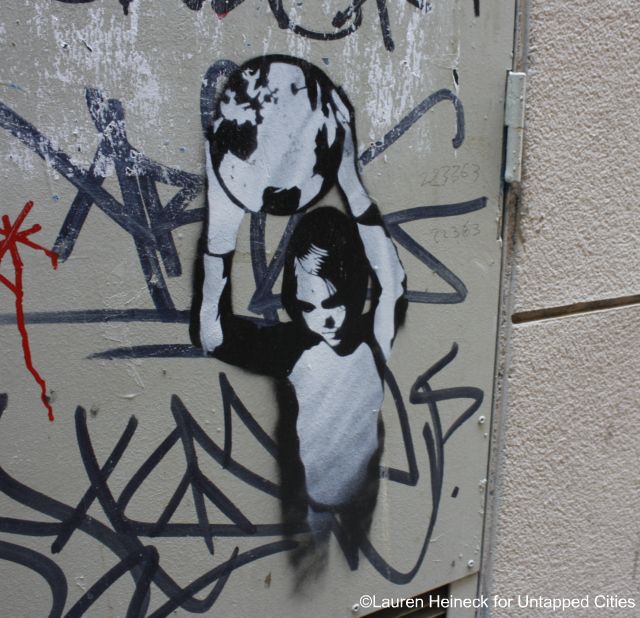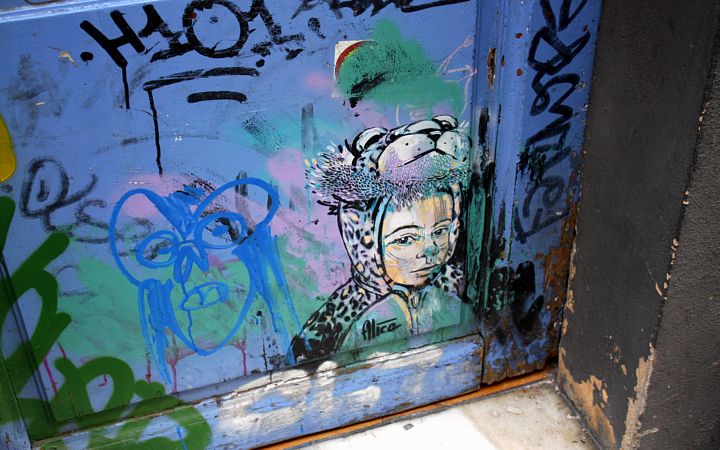A Salvaged Banksy Mural is Now on View in NYC
This unique Banksy mural goes up for auction on May 21st in NYC!


I recently came back to Barcelona on a whim, somewhat of a necessity but additionally without any plans to remain or return, or to go any other direction. I suppose I was lost, and Barcelona always allows me the comfort to dive inside her, to swim in circles if need be until I can stand on my own in the deep end. It’s a city I hold very dear to my heart: Barcelona provides me with many memories and opens her arms wide to receive me again and again.
On this last visit to the ‘Ciudad Condal‘ I encountered a similar soul, a wanderer like me – we hit it off and became fast friends – however, we both knew that this friendship would be short lived, like our time in Barcelona. Because it’s a transient city; people, businesses, heat, rain showers come and go like a ripple of the Mediterranean, the sea which it sits beside. Popular names such as Picasso, Hemingway and Manu Chao have left their footprint in this city, and for good reason; the streets are riddled with charm, character and life. Zigzagging from neighborhood to neighborhood, new discoveries await the urban explorer. It sometimes feels as though there is a place for everyone in Barcelona during some point of their life, although the difficulty of language, jobs and the wanderlust of many sweep the streets of their inhabitants like the twice daily street cleanings, inviting new souls and dust to settle the next day.
Even Untapped Cities contributor and photographer Sivan Askayo couldn’t get enough of what drew her aesthetically to this city, her adventure in Barcelona sparked a love affair.
Catalan, the official language of the autonomous community, la Comunitat de Catalunya, provides another element to this temporal feeling besieged on its visitors and immigrants. While not an impossible language, there are hot political feelings associated with the teachings, learnings and daily life activities that take place in a society which is believed by outsiders to be Spanish. Expats of Australia, the US or the UK are often confined to a period of teaching English or freelance work in their native language, and while they adore the city and their life in it, they bore of being pigeonholed, and they eventually move on. Regardless, this ephemeral effect on the city has its advantages, and the diversity and continuously throbbing energy of new talent being pumped in the city can be seen in its urban art and graffiti scene, also in its cultural offerings – but this could be at risk.
 Local urban street artist Pez has been known and commissioned by many of Barcelona’s vendors to paint their stores’ shutters.
Local urban street artist Pez has been known and commissioned by many of Barcelona’s vendors to paint their stores’ shutters.
 Barcelona’s ‘El Raval’ neighborhood is littered with street art from international artists eager to paint scenes throughout this diverse and ever gentrifying ‘barrio.’
Barcelona’s ‘El Raval’ neighborhood is littered with street art from international artists eager to paint scenes throughout this diverse and ever gentrifying ‘barrio.’
As I mentioned in a previous article about Madrid’s street art scene, Spain as a whole has struggled to let itself become too vulnerable to new things, particularly those perceived as artsy or alternative. The newly elected right-wing government has put the masses through a predicament as of late and in its spiral toward bankruptcy has made enormous budget cuts against education and culture (some artists have already expressed their vision of the current dilemma). As of September 1, 2012 a new law went into effect activating a tax of 21% on certain services. Those which were once considered to be basics are now thought of as a luxury. This means that everyday tasks like going to the barber shop, attending the gym, buying school supplies, going to the movies or attending a theater (of which Madrid and Barcelona have strong roots and actors with incredibly high talent), will be put into jeopardy for the average citizen of the state.
For pessimists this equates to destruction of an important part of life, a degradation of the spiritual and mental health of its residents. What will be left for the population if no one can afford to properly care for their children, support artists and craftsmen, allow themselves to laugh with a comedy, or cry with an opera? This is where I hope that graffiti artists around the globe can give life to the city, to brighten the streets from the misery that some people deem they are doomed to feel in the coming months, to put their work on display and inspire another generation to be creative, active and expressive, to encourage the fact that sitting behind a desk in a job that gives you security but little else is not the only window of opportunity. For many residents, it’s that or leave, and as strong as the heart strings of Barcelona may tug, the reality stands that for the time being a calmer, more inviting water awaits them somewhere else.
 An unknown stencil artist leaves behind a piece for contemplation regarding the 21st century definition of ‘El Dorado’ in El Born, Barcelona.
An unknown stencil artist leaves behind a piece for contemplation regarding the 21st century definition of ‘El Dorado’ in El Born, Barcelona.
So where is the light at the end of the tunnel? The key, and hopefully the Achilles’ heel of Barcelona is that she keeps alluring talent into the city, that she doesn’t allow her controlling and baleful policy makers to get the better of her, that she seduces those who fancy a dip regardless of the red flag at high tide. After all, the storm shall pass, and when it does, how nice will it be to fall in love with her all over again?
Things like this Kickstarter campaign curated by Katrine Knauer of Urban Artcade will become a reality, merging local Barcelona based artists with a myriad of expertise in the hopes of educating the public and sparking a dialogue with the city’s governing bodies. They are also responsible for the site Mapping Barcelona and will be celebrating the fundraiser’s success with an exhibit and documentary entitled Las Calles Hablan (the streets speak) this October.
 The whole world is in our hands. We’d like to think that citizens stop and think in front of this street art example in Barcelona.
The whole world is in our hands. We’d like to think that citizens stop and think in front of this street art example in Barcelona.
 Alice, a popular Italian street artist, stays quite busy with happy and bright colors portraying scenes of women of all ages throughout Barcelona, above all documented in the ‘El Raval’ area. Photo by Lauren Heineck.
Alice, a popular Italian street artist, stays quite busy with happy and bright colors portraying scenes of women of all ages throughout Barcelona, above all documented in the ‘El Raval’ area. Photo by Lauren Heineck.
Other websites such as bombarcelona and Street Art News also document Barcelona’s urban art. While it seems that those who admire these works are notably niche groups, with the government putting restrictions on so many other facets of Barcelonians’ daily life, undoubtedly a new coat of paint on the walls and streets should call their attention and create action. After all, street art, like love stories, are free manners of expression for all citizens, regardless of how long they stand and observe.
Get in touch with the author @laurenonthewknd
Subscribe to our newsletter